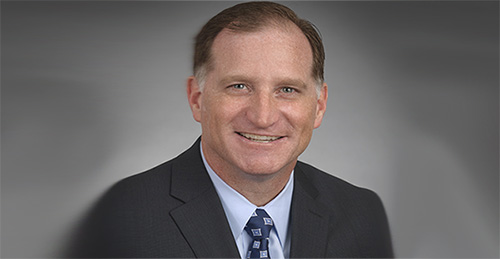 Booher: “It’s critical to develop relationships with all of your capital partners, particularly your lending sources.”
Booher: “It’s critical to develop relationships with all of your capital partners, particularly your lending sources.”
PITTSBURGH — In May of 2018, GlobeSt.com met with PNC Real Estate to look at the meaning of a flat yield curve. Despite the ominous sound, the period of expansion — now a record-breaker — still chugs along, with sound real estate fundamentals backed by a still-vibrant economy.
We joined PNC Real Estate again to talk about the 2019 outlook, and the group — Tom Booher, EVP and head of Agency Finance; and David Aloise and Daniel Mullinger, both EVPs and co-heads of Real Estate Banking — provided guidance on how borrowers can best read the market going forward.
GlobeSt.com: So, update us on the yield curve situation.
Daniel Mullinger: The expectations are pretty much the same as last year. Given some changes in how the Fed is posturing, some people are speculating that there’ll be a short-term drop. I don’t know that I subscribe to that.
 Mullinger: “Make sure you’re giving yourself flexibility should the market change from the time you start your project to when you deliver.”
Mullinger: “Make sure you’re giving yourself flexibility should the market change from the time you start your project to when you deliver.”
David Aloise: Since last year, we’ve actually seen further flattening of the yield curve and it recently inverted slightly. It’s hard to know for certain what’ll happen to the shape of the curve. It’s being influenced by a number of things, including interest rates in other parts of the world and the Fed’s move to a more neutral posture. And there are some technical things going on with respect to the Fed’s balance sheet, all of which will have some influence on the yield curve.
But this is now set to become the longest expansion on record, which suggests that we’re late-cycle. Having said that, domestic economic fundamentals remain relatively strong. We have good employment and wage growth, and corporate earnings are healthy, all of which is favorable for real estate. Notwithstanding some retail headwinds, our overall view, despite some flattening of rent growth, is consistent with most of our customers, namely that the outlook for 2019 remains fairly stable for real estate.
GlobeSt.com: So no one’s talking doom or gloom, just passed-peak. How does the level of demand look compared to a year ago, and what does your pipeline look like?
Tom Booher: The business I run is entirely focused on multifamily, but certainly within that space we’re seeing continued strong demand. Household formations continue to grow, particularly among millennials, and most of that is rental.
Mullinger: In other sectors, it depends on what business our clients are operating in. Retail continues to see closings, so there’s not a lot of demand in that space, except what’s coming from institutional players who want to redevelop assets or some grocery-related projects. There’s been very strong demand in industrial, which will continue. Office has been steady and it feels like that’ll continue as well.
Aloise: Speaking from the balance sheet side, our pipeline remains fairly healthy on a year-over-year basis. At this point it’s probably up slightly from last year, but it’s too early to predict that it constitute.
 Aloise: “Make sure that you have a really good handle on your costs.”
Aloise: “Make sure that you have a really good handle on your costs.”
GlobeSt.com: So, what’s the lending picture going forward?
Booher: In terms of agency lending, our pipeline remains strong as well. We continue to see exceptional competition in the space, and a lot of capital — both debt and equity. People are viewing it as the long-term place to be.
GlobeSt.com: What advice would you give to potential or first-time borrowers at this stage in the cycle — especially considering the throughput time of construction?
Aloise: From a construction perspective, we’re certainly seeing cost increases relating to both materials and labor. So if you’re contemplating a new project and taking on a construction loan, my advice would be to make sure that you have a really good handle on your costs.
Mullinger: You need to be focused on the overall capital stack and how you capitalize a project. It certainly doesn’t feel like the time to be pushing leverage, given the flattening of rents, as David mentioned earlier. So make sure you’re giving yourself flexibility should the market change from the time you start your project to when you deliver.
Booher: Especially for people new to the business or starting a new company this late in the cycle, it’s critical to develop relationships with all of your capital partners, particularly your lending sources. Inevitably there’ll be people exiting the market at some point. We tend to stay in the market through all aspects of a cycle, but as things tighten up, we also tend to focus on those customers with whom we have a relationship — those who value what we bring to the table.
David A. Aloise is an executive vice president and co-head of the Real Estate Banking segment within PNC Real Estate.
A veteran of the real estate finance industry, Aloise possesses extensive experience in all aspects of commercial real estate lending. Prior to joining PNC in 1995, he held various positions in the real estate departments of other banks.
Aloise is a member of the National Association of Industrial and Office Properties (NAIOP), the International Council of Shopping Centers (ICSC), the National Association of Real Estate Investment Trusts (NAREIT) and the National Multifamily Housing Council (NMHC). In addition, he has served on the board of a local nonprofit dedicated to diversity training awareness.
Aloise graduated from Columbia University in 1987 with a degree in economics.
Tom Booher is an executive vice president and head of the Agency Finance segment within PNC Real Estate. Booher has more than 30 years of experience in the real estate finance and multifamily housing industries, with an extensive background in capital and secondary mortgage markets. In his current role with PNC, he is responsible for overseeing agency debt originations, which include Fannie Mae, Freddie Mac and FHA loan products for both conventional and affordable multifamily housing properties.
Before joining PNC, Booher was executive vice president and Chief Operating Officer of TRI Capital Corporation in San Francisco, California. Prior to his affiliation with TRI, he served as vice President for Asset Management and General Counsel for The Patrician Companies in Bethesda, Maryland. He was also a partner specializing in real estate law at the Colton and Boykin law firm in Washington, D.C., and counsel to Ballard Spahr, Andrews & Ingersoll, also in Washington, D.C.
Booher earned a bachelor of arts with distinction from Dartmouth College and a Juris Doctor degree from Washington and Lee University School of Law.
Daniel J. Mullinger is an executive vice president and co-head of the Real Estate Banking segment within PNC Real Estate.
In his role, Mullinger has direct responsibilities for customers located in the Great Lakes, Central and West Regions. Additionally, he oversees support for customers located in Canada as well as the bank’s Agency Warehouse Lending group.
Mullinger has more than 24 years of commercial banking and real estate experience, having held various roles with large regional banks in Cincinnati and Cleveland, Ohio. He joined PNC through its acquisition of National City Corporation in December 2008 and led the Real Estate Banking integration. Before being named to his current position in March 2018, he led Real Estate Banking’s Western Region and served as Central Regional Manager prior to that role.
He is a member of the Mortgage Bankers Association Senior Lender Roundtable, the National Association of Industrial and Office Properties (NAIOP), the International Council of Shopping Centers (ICSC) and Urban Land Institute. He is a board member for the Northeastern Ohio Chapter of the Arthritis Foundation and Notre Dame Schools in Chardon, Ohio.
Mullinger is a graduate of the University of Cincinnati, where he received a bachelor of science in accounting and finance and earned a master’s of business administration from John Carroll University’s Boler School of Business.

















 Copyright © 2024 ALM Global, LLC. All Rights Reserved.
Copyright © 2024 ALM Global, LLC. All Rights Reserved.